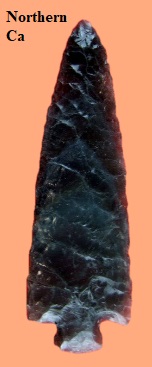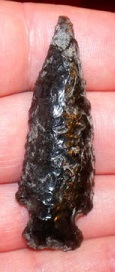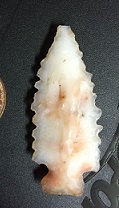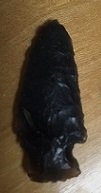Other Websites with Detailed Information:
Name Details:
Named By: Melvin Aikens
Named For: Wendover cultural period as described by Aikens, 1970
Date Identified: 1970
Type Site: Buffalo Jump, Owhee County, Idaho
Wendover
Cluster: Elko Cluster
Commonly Utilized Material:
basalt, chert, jasper, obsidian, rhyolite
Date:
Cultural Period:
7,000 - 5,000 B.P.
Middle Archaic
Middle Holocene to
Neoglacial
Glacial Period:
Culture:
Outline is Representative of Common Size and Shape:
Description of Physical Characteristics and Flaking Pattern:
This is a medium triangular expanding stem point with an elliptical cross section. The blade is primarily excurvate and is commonly serrated. The shoulders may vary from
horizontal to having a slight upward angle. The stem is expanding with a straight to convex base and commonly has rounded basal corners. This point is commonly crudely made and has a random flaking
pattern.
Size Measurements: Total Length - 41 to 86 mm,
Stem Length - 9 to 13 mm, Blade Width - 16 to 32 mm, Neck
Width - 9 to 18 mm, Basal Width - 11 to 22 mm
Distribution:
Distribution Comments:
This point is primarily found through out the Great Basin.
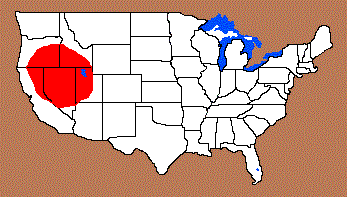
Related / Associated Points:
Additional Comments:
These points are commonly thick points that are made from thick flakes (Fagan, 1974).
There are considered two variants of the Wendover type. One is wider with wide corner notches, and the other is longer and has a slender blade with narrower notches (Justice, 2002).
Point Validity: Valid Type
Aikens is a distinguished anthropologist and professor emeritus for the Department of Anthropology at the University of Oregon. He conducted extensive studies, and is an expert on,
Great Basin archaeology. This point was named for examples found at the Buffalo Jump site in Idaho and examples found in Danger and Hogup cave in Utah. This point has many professional references and is
considered a valid type.
.
Age Details:
References: (See Reference Page, Entry Number):
16, 23, 30, 107
Wendover Projectile Point, Wendover Arrowhead
